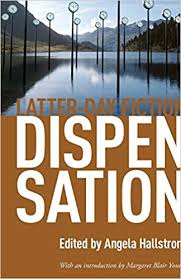Articles/Essays – Volume 44, No. 1
Navigating Mortality | Angela Hallstrom, ed., Dispensation: Latter-day Fiction
The cover of Dispensation: Latter-day Fiction shows clocks on long poles dipped into a blue lake surrounded by mountains. At first glance, the image symbolically suggests that this is the last dispensation and that all the writers included in the collection are products of these latter days. On second glance, though, the clocks also appear to be thermometers. That symbolism is equally appropriate, as each of the stories included in this collection takes the temperature of a certain spot in the deep waters of worldwide Mormonism, and the temperature may change, given the shifting sands of everyday events and the unfathomable molten core beneath the surface.
Some of the stories have historical settings. Two examples are Doug Thayer’s horrifying “Wolves” set during the Great Depression but focusing on the question of blood atonement and Phyllis Barber’s “Bread for Gunnar,” which addresses the challenge of polygamy. Others, however, are as current as today’s newspaper, These stories take place in contemporary Utah, where modern Mormons struggle to find reason and meaning behind unexpected upheavals or even just the daily grind of raising children and living life. Notable examples are Margaret Blair Young’s “Zoo Sounds” and Bruce Jorgensen’s “Measures of Music.”
In geographical contrast, two stories take place in contemporary Africa. In Paul Rawlins’s “The Garden,” a missionary runs for his life and hides in a poor black man’s vegetable patch. In “Quietly” by Todd Robert Peterson, a new convert is asked to dedicate the grave of a man found killed by Hutus and hanging upside down in a tree.
All fiction, of course, deals with mortals trying to navigate the conditions of mortal life that are no more comprehensible for being universal. We are born, we age, we die. We are subject to pain, affliction, and temptation. We cannot know the minds and hearts of others except for what they tell us or what we sense. Conflict is inevitable. These stories ask whether being a Mormon can save you, anchor you, break you, make you crazy, or bring you unspeakable joy. The manifold answers have as much to do with varying faith, knowledge, thought, and personality as they have to do with the nature of Mormonism itself.
Each story seems to plumb the depths of what it means to come in contact with the Church of Jesus Christ of Latter-day Saints, either regarding it as a peculiar feature of peculiar people, or embracing the complexities of faith and the hardship which that faith sometimes brings in its wake. Some question policies of the past. ”White Shell,” by Arianne Cope, illustrates ways that the Indian Placement Program, instituted by well-meaning Mormons, affected many lives for better but also for worse. Darrell Spencer’s “Blood Work” seems to say that being a Mormon can make you crazy. Brian Evensen’s “The Care of the State” suggests that being a Mormon can anchor you, while allowing that we’re all untethered in some way or other.
All the stories are thought-provoking, questioning, artistic, and eloquent; many transcend the confines of “Mormon” fiction. These are stories from mature writers who see the ambiguities and contradictions inherent in navigating the shoals of mortal life, whether their characters are clasping the iron rod or barely acknowledging its existence. Birth, death, divorce, conversion, living Mormon precepts, twisting them, relying upon them, or leaving them—all the conflicts of a Mormon’s mortal life are here.
In her “Preface,” Angela Hallstrom quotes Eugene England, to whom the book is dedicated, who said of his 1992 collection of Mormon short fiction, Bright Angels and Familiars: “Mormonism insists that divinity continues to reveal [truths] to prophets and further understanding of [these truths] to all people. One crucial way such insight can come, I believe, is through the telling of stories.“ These stories participate in that quest for revelatory storytelling, and invite thoughtful readers along for the journey.
Angela Hallstrom, ed. Dispensation: Latter-day Fiction. Introduction by Margaret Blair Young. Provo, Utah: Zarahemla Books, 2010. 458 pp. Paperback: $19.95. ISBN 978–0–9843603–0–7


 Back to full Issue
Back to full Issue

